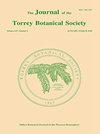Life history of Microstegium vimineum (Poaceae), an invasive grass in southern Illinois.
IF 0.8
4区 生物学
Q4 PLANT SCIENCES
引用次数: 148
Abstract
limited to one small area at the edge of the core population. At Dixon Springs, the germinable seed bank was estimated from soil samples collected in Fall 1999 before flowering, and in the subsequent spring. Seedlings emerged from soils placed in a greenhouse from samples collected in the spring. No seedlings emerged from samples collected in the fall. Germinable seed had a 10 times higher density in samples collected near the soil surface than from samples collected at 5-10 cm depth. Seed dispersal occurred within the main population only. Despite the lack of seed dispersal in 1999, seedlings emerged from six of seven subpopulations in spring 2000, with the highest densities where plants had flowered in 1999. These data indicate the presence of a persistent soil seed bank for M. vimineum. Even following summer drought and discounting spring seedling emergence, the size of the seed bank increased by -25% in 1999. Reestablishment of the Dixon Springs population following the 1999 drought was vigorous, but the location of the largest, most fecund plants in 2000 was not the same as in 1999. In 2000, end of season survivorship of M. vimineum among all populations was 40-50%, with 90% of surviving individuals flowering. Performance of M. vimineum varied significantly within and among populations and was related to soil texture and chemistry, and overhead canopy cover. The findings of our study reflect the invasive nature of this plant. A sufficiently large seed bank and a highly plastic morphological response to local microhabitat conditions likely ensures its persistence in invaded sites.美国伊利诺斯州南部入侵禾本科禾本科草的生活史研究。
仅限于核心人口边缘的一小块区域。在Dixon Springs,根据1999年秋季开花前和随后的春季收集的土壤样本估计了可发芽种子库。幼苗从春天收集的样品中生长出来。在秋天采集的样本中没有出现幼苗。在土壤表面附近收集的可发芽种子的密度比在5-10 cm深度收集的种子高10倍。种子传播只发生在主要种群内。尽管1999年缺乏种子传播,但在2000年春季,7个亚种群中的6个出现了幼苗,在1999年植物开花的地方密度最高。这些数据表明葡萄分枝杆菌存在一个持久的土壤种子库。即使在夏季干旱和春季幼苗出苗率下降之后,1999年种子库的规模仍增加了-25%。在1999年干旱之后,迪克森斯普林斯的种群数量得到了有力的恢复,但2000年最大、最肥沃的植物的位置与1999年不同。2000年,葡萄分枝杆菌在所有种群中的季末存活率为40-50%,其中90%的存活个体开花。葡萄分枝杆菌在种群内和种群间的生长表现差异显著,且与土壤质地、化学性质和冠层盖度有关。我们的研究结果反映了这种植物的入侵性。一个足够大的种子库和对当地微生境条件的高度可塑性形态响应可能确保其在入侵地点的持久性。
本文章由计算机程序翻译,如有差异,请以英文原文为准。
求助全文
约1分钟内获得全文
求助全文
来源期刊
CiteScore
0.70
自引率
0.00%
发文量
16
审稿时长
>12 weeks
期刊介绍:
The Journal of the Torrey Botanical Society (until 1997 the Bulletin of the Torrey Botanical Club), the oldest botanical journal in the Americas, has as its primary goal the dissemination of scientific knowledge about plants (including thallopyhtes and fungi). It publishes basic research in all areas of plant biology, except horticulture, with an emphasis on research done in, and about plants of, the Western Hemisphere.

 求助内容:
求助内容: 应助结果提醒方式:
应助结果提醒方式:


